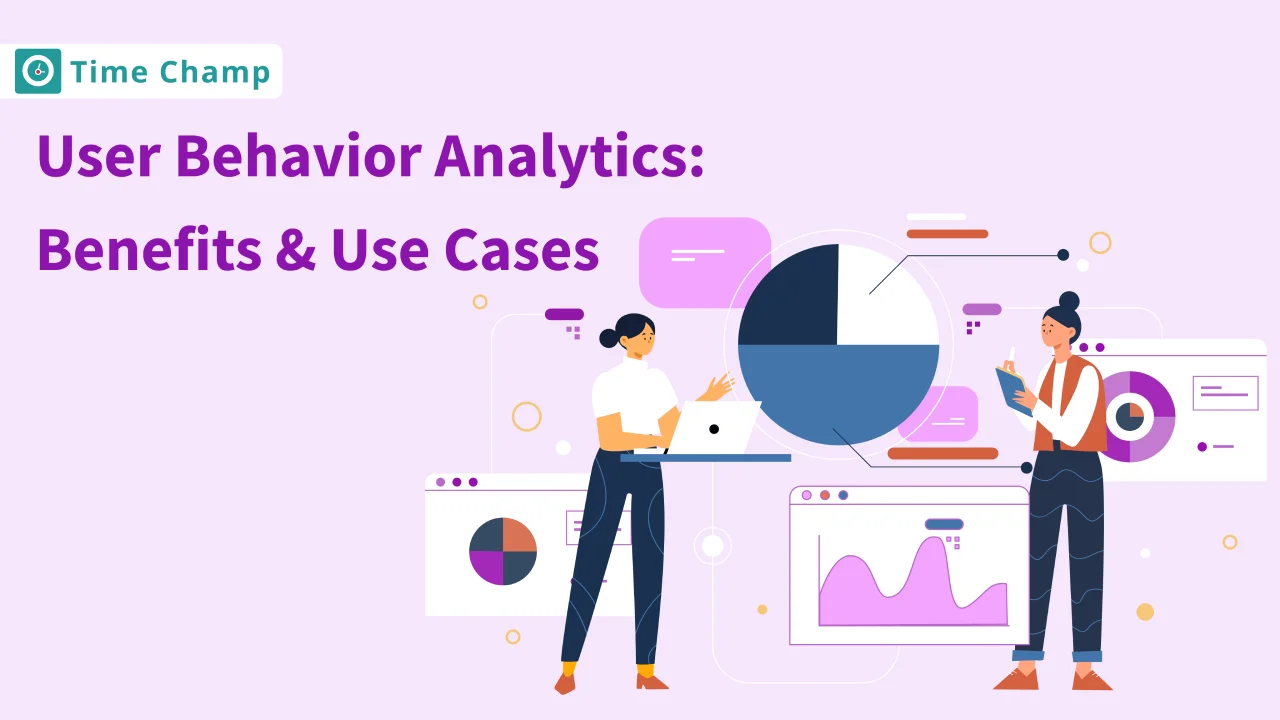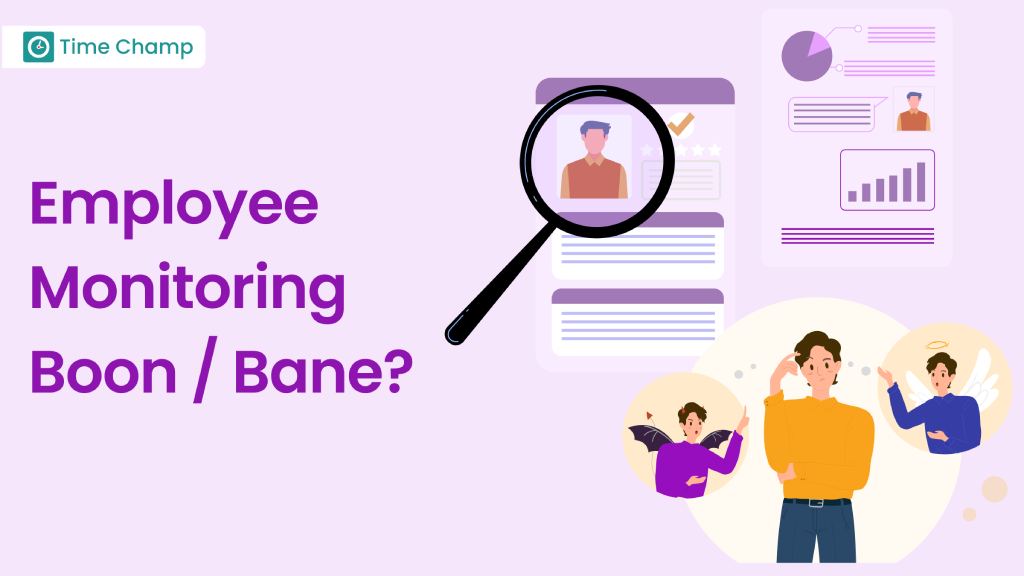Cybersecurity in today’s world is a universal concern for all kinds of organizations. UBA tools thus have become an important answer to the problem of security, by tracking and collecting user data for analysis to detect threats. By examining the fine points of user activity with corporate networks and systems, UBA provides a new type of active defence that moves beyond traditional perimeter security. In this blog post, we will explore the field of UBA. We’ll take a look at various solutions on the market and analyze how these tools can help you in your day-to-day operations. We also want to examine real-world applications of UBA in action and the place of machine learning in boosting its effectiveness.
If you want to understand your organization’s inner workings, increase productivity, or enhance security for its members and assets, make sure to explore the Time Champ Workforce Management & Analytics Suite.
Understanding User Behavior Analytics (UBA):
Also known as user behavior analytics, this is the study of ways to track and collect such data and analyze it to detect anomalies that could indicate a security threat. UBA systems compare the user’s activities with those established a priori and point out any aberrations that might signify an impending information security event. These analytics can enable organizations to detect insider threats, compromised accounts, and other forms of misuse early on so they don’t have time to grow into serious security breaches.
UBA Products and Tools:
As for choosing user behavior analytics products, the market offers a lot of variety to reflect the different needs and security concerns of organizations. Some leading UBA tools include:
- Exabeam: Exabeam uses machine learning to automatically detect anomalies and risky user behavior, thus giving organizations advanced detection of threats.
- Rapid7 InsightIDR: It includes outcome-based, end-to-end incident detection and response with UBA to provide rich insight into user behavior across the network.
- Splunk User Behavior Analytics: By adopting its UBA tool, Splunk’s powerful logging and monitoring capabilities allow you to gain insight into user behavior.
Each of these products has features capable of tracking user activities and identifying suspicious patterns or behavior that can lead to a threat. The right tool depends on the case, the size of your organization, and the complexity of its IT infrastructure.
Benefits of User Behavior Analytics:
UBA offers many benefits to organizations wishing to shore up their security position. The primary benefits include:
- Enhanced Detection of Insider Threats: UBA tools take advantage of user behavior monitoring to find any actions that appear to be the unauthorized work of an employee or insider.
- Improved Incident Response: UBA provides rapid identification and issuing of alerts on suspicious activities. This allows quicker responses and remediation when an incident occurs.
- Risk and Compliance Management: A clear audit trail of user actions UBA can help organizations maintain compliance with industry regulations and standards.
User Behavior Analytics Use Cases:
In the areas where understanding user behavior is crucial to security and operational efficiency, user behavior analytics has already established a firm foothold. Here are a few typical UBA use cases:
- Detecting Compromised Credentials: UBA can discover when a user’s behavior has taken an unexpected turn, perhaps indicating that their credentials have been compromised.
- Identifying Data Exfiltration: Abnormal access or transfer of data may indicate that sensitive information is in danger. In real-time, UBA can warn organizations of those activities.
- User behavior analytics do serve as a keystone in cybersecurity; they play an important part in identifying and containing threats before wounds can be inflicted. For the shallowest guys in this second batch, we will go into considerable detail about UBA’s benefits. We will also look at some of your more specialized options as well as how machine learning is leaving its mark on user behavior analytics.
Detailed Benefits of User Behavior Analytics:
User behavior analytics offers numerous benefits that enhance an organization’s ability to safeguard its digital environment:
- Advanced Threat Detection: Traditional approaches to security typically use signature-based detection. UBA, on the other hand, relies upon advanced algorithms to discover actions that traditional security systems would be incapable of detecting, such as lateral movement within a network or accessing data outside normal working hours.
- Reducing False Positives: UBA-based systems, by establishing normal behavioral thresholds, can more accurately separate legitimate activities from possible threats. Minimizing the number of false positives means attention by security personnel is concentrated on true risks.
- Forensic Capabilities: UBA provides a complete record of user activities, thereby providing forensic capabilities for post-incident analysis. By identifying the steps of a cyber-attack organizations can track back to where it came from and how it got in, and adjust their defensive strategy accordingly.
Exploring User Behavior Analytics Tools:
Tools are transforming the field of user behavior analytics. Each provides a different range of capabilities against an ever-changing threat landscape. Let’s take a closer look at some notable ones:
- Varonis DatAdvantage: This platform uses UBA to analyze data, account activity, and user behavior so that users only see the data they have a right to access for their job.
- Aruba IntroSpect: A key part of this comprehensive security framework for Aruba is UBA. Making use of AI-based analytics, along with actionable insights, the company can quickly detect and respond to advanced cyberattacks.
- ObserveIT: With ObserveIT, real-time monitoring and analytics make it easier to pick out risky user activities. Their focus on insider threat detection also helps companies support their regulatory compliance initiatives.
Applying Machine Learning in User Behavior Analytics:
Introducing machine learning into user behavior analytics adds another layer of refinement, as systems can learn and adapt in time. ML algorithms can learn from the data to create more accurate behavioral models, leading to the following enhancements:
- Dynamic Pattern Recognition: As with ML, UBA systems can gradually extrapolate normal behavior, making adjustments based on the new patterns that emerge within an organization’s user base.
- Predictive Analysis: It can’t just detect current threats, but anticipate future issues. By examining trends and anomalies, it can predict where and how safety problems might crop up in the future.
- Automated Response: By putting ML on UBA platforms, some responses to threats that can be automated today can trigger an alert or prevent access more quickly. Doing so closes a window for attackers with the fewest problems.
User Behavior Monitoring and Data Insights:
At its core, user behavior analysis depends on monitoring user actions and the interpretation of that information. This encompasses a vast range of activities, such as:
- Log-in/log-out times
- File access patterns
- Application usage
- Email interactions
- Network traffic behavior
These data points can be holistically analyzed to identify uncommon behavior that hints at an internal threat, a compromised user account, or an external attacker with stolen credentials.
As for data analysis and monitoring, it is necessary to discuss the ethical and privacy concerns. Although UBA can greatly increase security, it needs to be balanced by user privacy and legal regulation. With this equilibrium teetering, transparent policies and the clear communication of monitoring practices can help in maintaining it.
By all means, Time Champ is the kind of platform that organizations should explore to adopt UBA tools. It not only tracks data on user behavior but also does so privately.
You will also want to look at Time Champ, for highly customized analytics in user activity monitoring that fits right into your choice of analytics tools without having to use any additional software. And remember, our approach is very ethical about dealing with internal users’ behavior and the ways we go a step further from there are all detailed on our Web site.
Turning now to additional applications and use cases of UBA tools, in this article we continue our in-depth examination of User Behavior Analytics. In addition, we will discuss how UBA plus machine learning not only helps organizations keep up with an ever-changing cybersecurity environment but also gives our conclusions.
User Behavior Analytics: Expanding Use Cases
UBA has applications far beyond those already mentioned in various business areas. Here are more instances where UBA proves invaluable:
- Preventing Fraudulent Transactions: In the financial services sector, UBA can identify irregular transaction patterns and therefore help fraud from being detected before funds are lost forever.
- Enhancing Security in Healthcare: Analytics help healthcare providers protect against unauthorized access to sensitive health records using UBA.
- Optimizing User Experience: Apart from security, e-commerce platforms utilize UBA to analyze customer behavior, personalizing accordingly to generate sales and satisfaction.
User Behavior Analysis Tools in-depth Insights:
Each UBA tool provides a set of capabilities tailored to the needs of a branch of industry. A closer examination of some tools demonstrates their versatility and effectiveness:
- LogRhythm: By quickly honing in on deviations from a user baseline, LogRhythm’s UBA features help reduce the time to detect and respond to threats.
- Forcepoint: This tool is particularly noteworthy in its ability to adapt protection measures in real time according to the evaluation of risks faced by users.
- Gurucul: This provides a competitive edge in security management, including creating risk scores for employee behavior and predicting insider threats.
Machine Learning’s Role in UBA:
With such copious amounts of user behavior data in the hands of machine learning algorithms, they’re able to detect even the most subtle underlying patterns and pinpoint future actions. UBA’s predictive power transforms it from a defensive mechanism into an anticipatory security tool. Using historical information, ML algorithms anticipate threats from cybersecurity. Risks are unearthed and discovered before they appear.
Conclusion:
In a time when data is a treasure and poison, User Behavior Analytics is a digital knight. From greater defense against advanced cyber attacks to valuable information on user activity, networks such as UBA have many advantages. UBA’s effective application scenarios prove its flexibility and indispensability in our rich threatscape today.
UBA, reinforced by machine learning, provides the vigilance and intelligence required to adapt effectively in a world where organizations are swamped with data, and full of internal and external threats. Through the use of these analyses, businesses can see what legitimate users are doing and who are rogues. From there they make informed decisions–about how to protect sensitive information or maintain operations, for example.
However, for those who are willing to accept UBA as their future in cybersecurity, tools such as Time Champ provide a comprehensive platform integrating user monitoring and behavior analytics. The combination provides the makings of an overall cybersecurity and productivity solution.
FAQS on User Behavior Analytics
UBA monitors for unusual access or usage of information within the network that doesn’t conform to the established user behavioral baseline
Organizations implement UBA by integrating analytics tools that monitor user behavior. Solutions like Time Champ
provide comprehensive monitoring capabilities that facilitate the implementation of UBA





